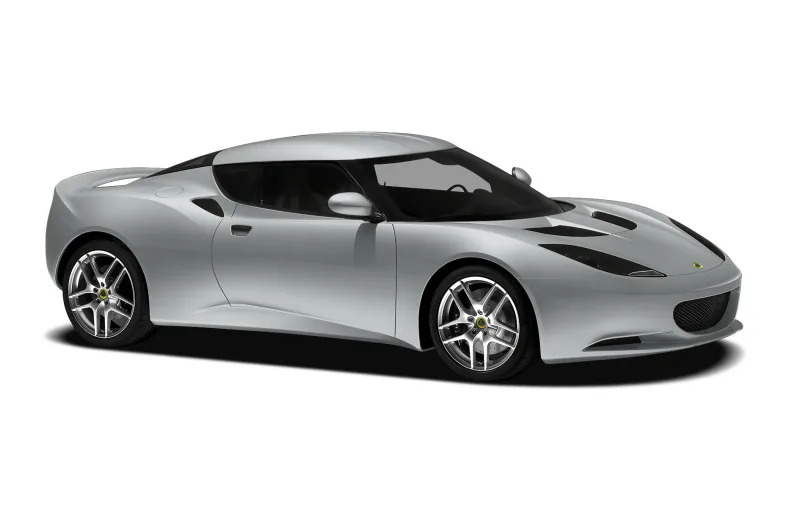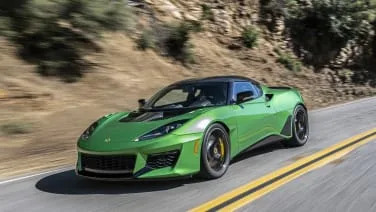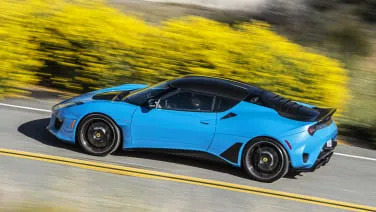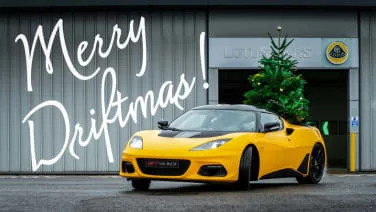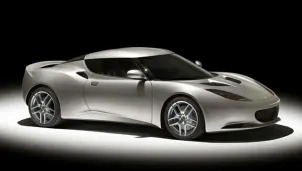2011 Lotus Evora
I have a general rule: Don't turn off traction control in anything over 350 horsepower. Adhering to this self-imposed restriction has kept your humble hack out of the weeds more times than I can count. But on my second-to-last lap around Laguna Seca in the 2011 Lotus Evora S, I just couldn't help myself. After all, it's only making 345 horses... Just as I was cresting the ton down the front straight, I held down the aluminum button on the left side of the dash, saw the orange light illuminate on the instrument cluster and dove into Turn One with a fair amount of trailbraking. As the front end began to ever-so-slightly wash out, I gave it the boot and performed one of those life-affirming powerslides through One and Two, making the slightest of corrections on the wheel, grazing the curbing with the right rear tire and powering into the slight right hander that leads into Turn Three. Ego briefly stroked, I reengaged the electro-nannies, barreled through Four and Five, and with Sport Mode set, managed a four-wheel-drift through turn six before making the long trek up to The Corkscrew. Good cars make you feel like a hero. Great cars compliment and connect with every fiber of your being. The Evora S falls into the latter camp. And it's even better on the open road. When none other than Dan Neil says of the standard, naturally aspirated Evora, "In my career as an automotive journalist, I've never written these words: I am going to buy one," you know it's good. But as of today, The Esteemed Mr. Neil hasn't called up his local Lotus dealer and cut a check for the $64,000(ish) 2+2(ish). Why? Because he knew something better was around the corner. That something better is the Evora S. With the same 3.5-liter V6 mounted amidships as the standard Evora, Lotus has done the predictable, slapping a Harrop HTV 1320 supercharger on top of the Toyota-sourced six-cylinder like an aluminum cherry on top of one incredibly delectable four-wheeled sundae. The result is a boost in output from 276 to 345 hp (peaking at 7,000 rpm) and torque rises from 258 to 295 pound-feet (at 4,500 rpm). The addition of the blower nets a 0-60 mph run of 4.3 seconds (down from 4.9 on the standard Evora), 0-100 mph in 10.2 ticks (improved by nearly a second and a half) and a quarter-mile time of 12.8 seconds at 110 mph. While those increases don't look like much on paper, the additional motivation down low – particularly up hills and across straight stretches of tarmac – is exactly what the doctor ordered. Base torque in the Evora S is the same as peak torque in the standard coupe, providing authoritative shove across the rev range until around 6,200 rpm when twist begins to bleed off. And the combination of the blower whine, intake noise and engine note – enhanced by a small valve that opens up the exhaust – makes it …
Full Review
I have a general rule: Don't turn off traction control in anything over 350 horsepower. Adhering to this self-imposed restriction has kept your humble hack out of the weeds more times than I can count. But on my second-to-last lap around Laguna Seca in the 2011 Lotus Evora S, I just couldn't help myself. After all, it's only making 345 horses... Just as I was cresting the ton down the front straight, I held down the aluminum button on the left side of the dash, saw the orange light illuminate on the instrument cluster and dove into Turn One with a fair amount of trailbraking. As the front end began to ever-so-slightly wash out, I gave it the boot and performed one of those life-affirming powerslides through One and Two, making the slightest of corrections on the wheel, grazing the curbing with the right rear tire and powering into the slight right hander that leads into Turn Three. Ego briefly stroked, I reengaged the electro-nannies, barreled through Four and Five, and with Sport Mode set, managed a four-wheel-drift through turn six before making the long trek up to The Corkscrew. Good cars make you feel like a hero. Great cars compliment and connect with every fiber of your being. The Evora S falls into the latter camp. And it's even better on the open road. When none other than Dan Neil says of the standard, naturally aspirated Evora, "In my career as an automotive journalist, I've never written these words: I am going to buy one," you know it's good. But as of today, The Esteemed Mr. Neil hasn't called up his local Lotus dealer and cut a check for the $64,000(ish) 2+2(ish). Why? Because he knew something better was around the corner. That something better is the Evora S. With the same 3.5-liter V6 mounted amidships as the standard Evora, Lotus has done the predictable, slapping a Harrop HTV 1320 supercharger on top of the Toyota-sourced six-cylinder like an aluminum cherry on top of one incredibly delectable four-wheeled sundae. The result is a boost in output from 276 to 345 hp (peaking at 7,000 rpm) and torque rises from 258 to 295 pound-feet (at 4,500 rpm). The addition of the blower nets a 0-60 mph run of 4.3 seconds (down from 4.9 on the standard Evora), 0-100 mph in 10.2 ticks (improved by nearly a second and a half) and a quarter-mile time of 12.8 seconds at 110 mph. While those increases don't look like much on paper, the additional motivation down low – particularly up hills and across straight stretches of tarmac – is exactly what the doctor ordered. Base torque in the Evora S is the same as peak torque in the standard coupe, providing authoritative shove across the rev range until around 6,200 rpm when twist begins to bleed off. And the combination of the blower whine, intake noise and engine note – enhanced by a small valve that opens up the exhaust – makes it …
Hide Full Review
Hide Full Review
Retail Price
$64,000 - $81,500
MSRP / Window Sticker Price
| Engine | 3.5L V-6 |
| MPG | Up to 18 city / 26 highway |
| Seating | 2 Passengers |
| Transmission | 6-spd man w/OD |
| Power | 276 - 345 hp |
| Drivetrain | rear-wheel |
| Curb Weight | 3,047 - 3,166 lbs |
Smart Buy Program is powered by 

